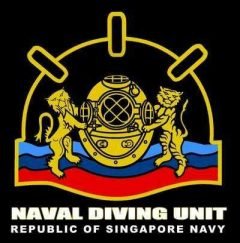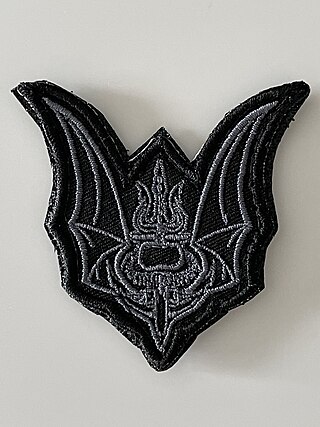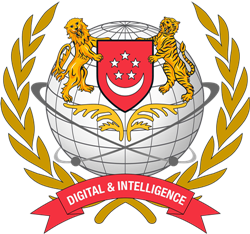Related Research Articles

A coast guard or coastguard is a maritime security organization of a particular country. The term embraces wide range of responsibilities in different countries, from being a heavily armed military force with customs and security duties to being a volunteer organization tasked with search and rescue without law enforcement authority. In most countries, a typical coast guard's functions are distinct from those of the navy and the transit police, while in certain countries they have similarities to both.

The Singapore Armed Forces (SAF) are the military services of the Republic of Singapore, responsible for protecting and defending the security interests and the sovereignty of the country. A military component of the Ministry of Defence (MINDEF), the armed forces have four service branches: the Army, the Navy, the Air Force, and the Digital and Intelligence Service. An integrated force, it is one of the most capable, robust, technologically sophisticated and powerful militaries in Southeast Asia and the surrounding regions. The SAF is headed by the chief of defence force, appointed by the president of Singapore, on the advice of the Cabinet.

The Republic of Singapore Navy (RSN) is the maritime service branch of the Singapore Armed Forces (SAF) responsible for defending the country against any seaborne threats and as a guarantor of its sea lines of communications. The RSN traces its origins to the Royal Navy when Singapore was still a crown colony of the British Empire. The service was formally established in 1967, two years after its independence from Malaysia in 1965, and had undergone a substantial modernisation ever since – which has led them into becoming the most powerful navy in Southeast Asia.

The Singapore Army is the land service branch of the Singapore Armed Forces (SAF). The largest of the four branches of the SAF, the Singapore Army traces its origins to the 1st Battalion, Singapore Infantry Regiment, which was formed in 1957, when Singapore was still under British colonial rule. After Singapore's independence on 9 August 1965, the Singapore Army Bill was passed in Parliament on 23 December 1965, and National Service (NS) was subsequently introduced in 1967. Mostly made up of conscripts, the Singapore Army can mobilise all operationally-ready military reservists in the event of war or national exigencies.

The Formidable-class multi-role stealth frigates are multi-mission derivatives of the French Navy's La Fayette-class frigate with the Republic of Singapore Navy. The six ships form the First Flotilla of the Navy.

The Naval Diving Unit (NDU), also referred to as the Naval Divers, is the special forces formation of the Republic of Singapore Navy (RSN) responsible for conducting special operations from sea, air, and land. The formation is made up of six squadrons, specialising in explosive ordnance disposal, underwater demolition, maritime security operations, and combatant craft operations.
Counter-terrorism in Singapore is a series of detection and prevention measures to minimize the damage caused by terrorism. These measures involve the participation of all levels of society, including defence, internal security, border and infrastructure security, civil defense, and gives special focus on areas such as medical readiness and psychological preparedness.

The Special Warfare Group (SWG) is the primary special forces unit of the Republic of Singapore Navy (RSN) responsible for conducting special operations from sea, air, and land. It is one of six squadrons of the Naval Diving Unit (NDU).

The Police Coast Guard (PCG) is a division of the Singapore Police Force that combines the functions of marine police and coast guard in Singapore. Its duties include the law enforcement and search and rescue operations in collaboration with the Maritime and Port Authority of Singapore and the Immigration and Checkpoints Authority. It is headquartered at Brani Regional Base on Pulau Brani.

The Endurance-class tank landing ships (LST) are the largest class of ships in the Republic of Singapore Navy (RSN). They were designed and built by Singapore Technologies (ST) Marine to replace the old County-class tank landing ships. The four ships form the Third Flotilla of the RSN.

The 121 Squadron "Brahminy Kite" of the Republic of Singapore Air Force (RSAF) currently operates the Fokker 50 Utility Aircraft (UTA) and Maritime Patrol Aircraft (MPA) based at Changi Airbase (West). The squadron goes by the motto of "Seek and Destroy" and the mascot is the brahminy kite.

The Bedok class are mine countermeasures vessels of the Republic of Singapore Navy (RSN). They play an important role in the maritime security of Singapore, ensuring that the Singapore Strait and the sea lanes surrounding Singapore remain mine-free and open to international shipping. It is estimated that closure of Singapore's ports would result in direct trade losses amounting to more than US$1.2 billion daily, posing a serious threat to Singapore's economy. The four ships form the Sixth Flotilla of the RSN.

The Marine Assault Team (MAST), formally known as the UNGERIN is a maritime counter terrorism and tactical unit of the Royal Malaysia Police's Marine Operations Force. Fully operational in 2007, the UNGERIN conducts anti-piracy and counter-terrorism operations in the coastal waters surrounding Malaysia and assists the marine police to respond swiftly.

The Special Operations Task Force (SOTF) is a special operations command of the Singapore Armed Forces (SAF) responsible for conducting special operations. The SOTF is composed of only highly-trained regular servicemen from the Army's Special Operations Force (SOF) under the Commandos formation and, the Navy's Special Warfare Group (SWG) under the Naval Diving Unit (NDU).

The Maritime Security Command is one of five operational commands of the Republic of Singapore Navy (RSN), responsible for building up, training and maintaining the capabilities of RSN platforms that are deployed primarily for maritime security operations. It was first established as the Coastal Command (COSCOM) in January 1988, before its restructuring in January 2009.

Brunei and Singapore established diplomatic relations in 1984. Brunei has a high commission in Singapore, and Singapore has a high commission in Bandar Seri Begawan. Brunei and Singapore have close and friendly relations with extensive defence co-operation. Both countries are members of ASEAN and Commonwealth of Nations.

MV Swift Rescue is a submarine support and rescue vessel (SSRV) that is operated by the Republic of Singapore Navy (RSN). The ship is stationed in Changi Naval Base and has a mixed crew of 27 personnel from the RSN and Swire Pacific Offshore Operations Pte Ltd, the marine arm of Swire Group.

The Home Team Science and Technology Agency (HTX) is a statutory board under the Ministry of Home Affairs of Singapore to develop science and technology capabilities for Home Team operations.
MV Avatar was a general cargo vessel in service with the Republic of Singapore Navy as a training vessel. She is owned by Valour Offshore Marine Services and was leased to the Defence Science and Technology Agency from 2001-2023, a statutory board under the Ministry of Defence. Avatar was not a commissioned navy warship and flew the state marine ensign instead of the naval ensign.

The Digital and Intelligence Service (DIS) is the digital service branch of the Singapore Armed Forces (SAF) responsible for providing military intelligence to the armed forces, building up the country's digital defence capabilities, and protecting the psychological defence of its military personnel. It was established on 28 October 2022, in response to the increased number of attacks by non-state actors, and the resulting damage from the Russian–Ukrainian cyberwarfare.
References
- ↑ Ng, Kelly (7 April 2016). "SAF ramps up counter-terror capabilities". Today.
- 1 2 A Maritime Force for a Maritime Nation: Celebrating 50 Years of the Navy. Straits Times Press. 2017.
- ↑ Mulqueen, Michael; Sanders, Deborah; Ian Speller (2016). Small Navies: Strategy and Policy for Small Navies in War and Peace. Routledge.
- ↑ Parameswaran, Prashanth (2 September 2015). "How Did a Singapore Warship Foil a Pirate Attack?". The Diplomat.
- 1 2 Bowers, Ian; Koh, Collin (2019). Grey and White Hulls: An International Analysis of the Navy-Coastguard Nexus. Springer Nature.
- 1 2 3 Goldrick, James; McCaffrie, Jack (2012). Navies of South-East Asia: A Comparative Study. Routledge.
- ↑ DeSilva-Ranasinghe, Sergei (June 2012). "The Republic of Singapore Navy". Headmark (144).
- ↑ Raska, Michael (2015). Military Innovation in Small States: Creating a Reverse Asymmetry. Routledge.
- 1 2 Heng, Yee-Kuang (2016). Managing Global Risks in the Urban Age: Singapore and the Making of a Global City. Routledge.
- ↑ Lee, Yinghui (1 December 2021). "Singapore's Conceptualization of Maritime Security". Asia Maritime Transparency Initiative.
- ↑ Chang, Ai-Lien; Tee, Zhuo (1 February 2019). "A*Star to be headed by Mindef deputy secretary Frederick Chew from April 1". The Straits Times.
- ↑ Koh, Fabian (27 June 2019). "Commander of maritime task force in charge of securing Singapore's waters off Tuas among 500 promoted". The Straits Times.
- ↑ Lim, Min Zhang (12 December 2020). "Pioneer RSN sailor shares memories as last two patrol vessels are decommissioned". The Straits Times.
- ↑ Mahmud, Aqil Haziq (2 March 2020). "SAF to restructure intelligence and cyber defence units, acquire new ships for maritime security amid evolving threats". Channel News Asia.
- ↑ Mahmud, Aqil Haziq (29 June 2020). "COVID-19 delays new submarines, but delivery of F-35 fighter jets on track: Ng Eng Hen". Channel News Asia.
- ↑ Rauf, Taofiq (28 August 2020). "Bakamla RI dan MSTF Kerja Sama Pertukaran Informasi". InfoPublik.
- ↑ Mukherjee, Anit (2015). Merlion And The Ashoka, The: Singapore-india Strategic Ties. World Scientific.
- ↑ Desker, Barry; Ang, Cheng Guan (2015). Perspectives On The Security Of Singapore: The First 50 Years. World Scientific.
- ↑ Frécon, Eric (28 March 2020). "Commentary: A cat-and-mouse game between pirates and Southeast Asian maritime security authorities". Channel News Asia.
- ↑ Koh, Fabian (10 March 2021). "Regional maritime security requires international cooperation: Zaqy Mohamad". The Straits Times.
- ↑ Parameswaran, Prashanth (30 September 2016). "Singapore Hosts Military Exercise to Counter WMD Proliferation". The Diplomat.
- ↑ Cheng, Kenneth (30 June 2017). "Across land, air and sea, SAF beefs up defences to fight terror". Today.
- ↑ Law, Francis Micah (5 November 2015). "Unmanned surface vessel featured at maritime security exercise". TYoday.
- ↑ Mahmud, Aqil Haziq (12 November 2021). "Singapore developing improved system to detect maritime threats 'as early and as far away' as possible". Channel News Asia.
- ↑ Yong, Clement (3 November 2020). "Inter-agency maritime security exercises held to ready Singapore's response to potential terrorist attacks". The Straits Times.